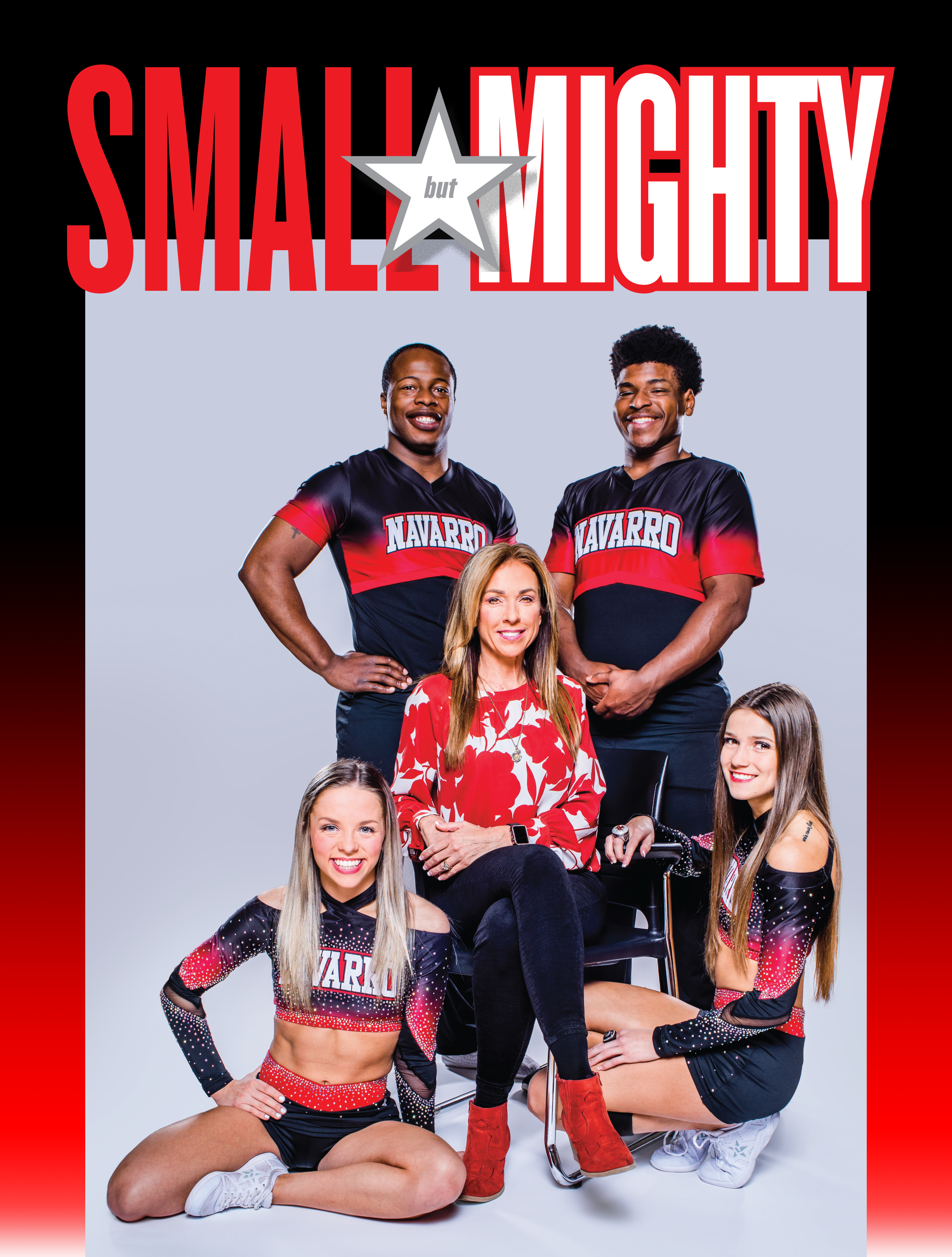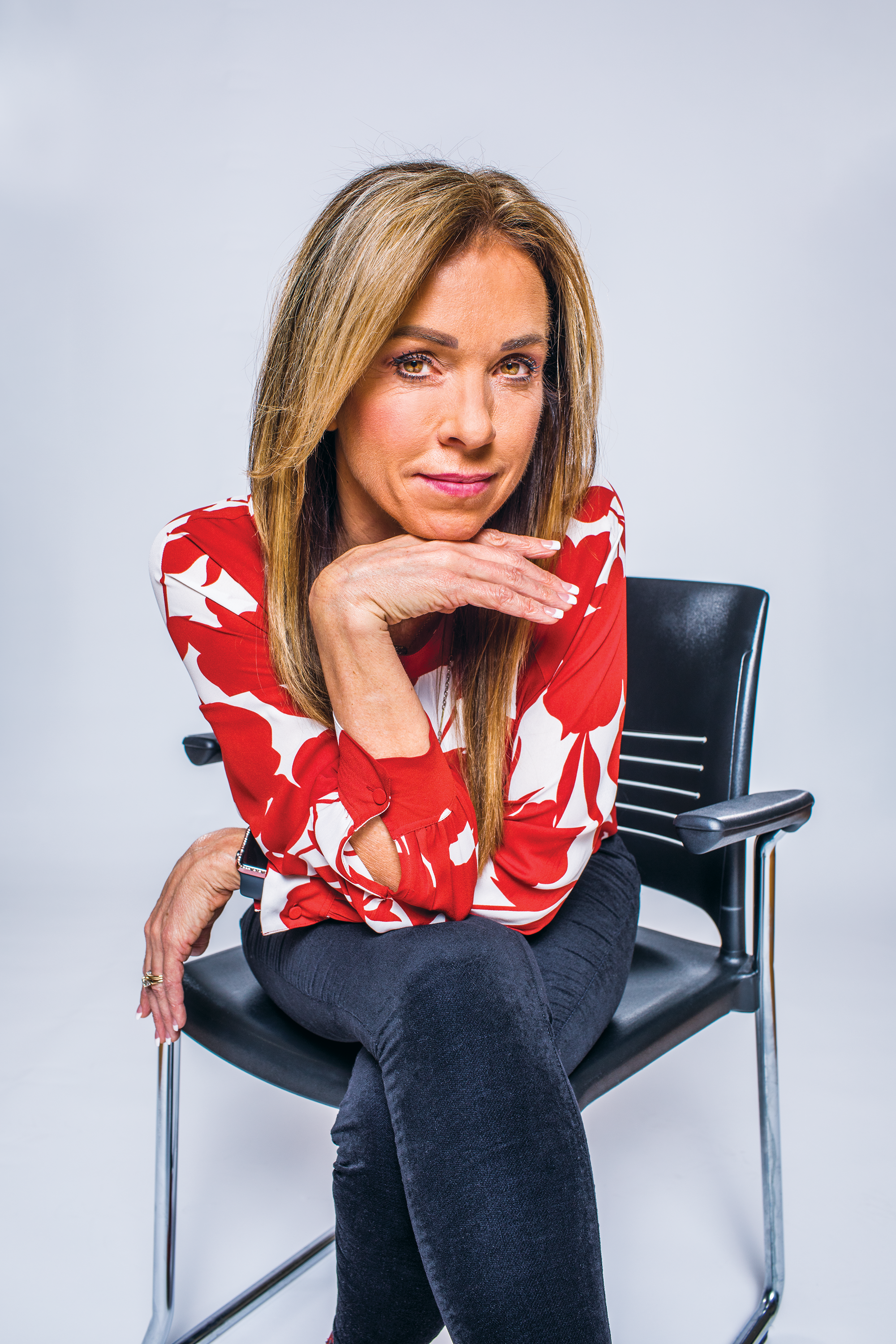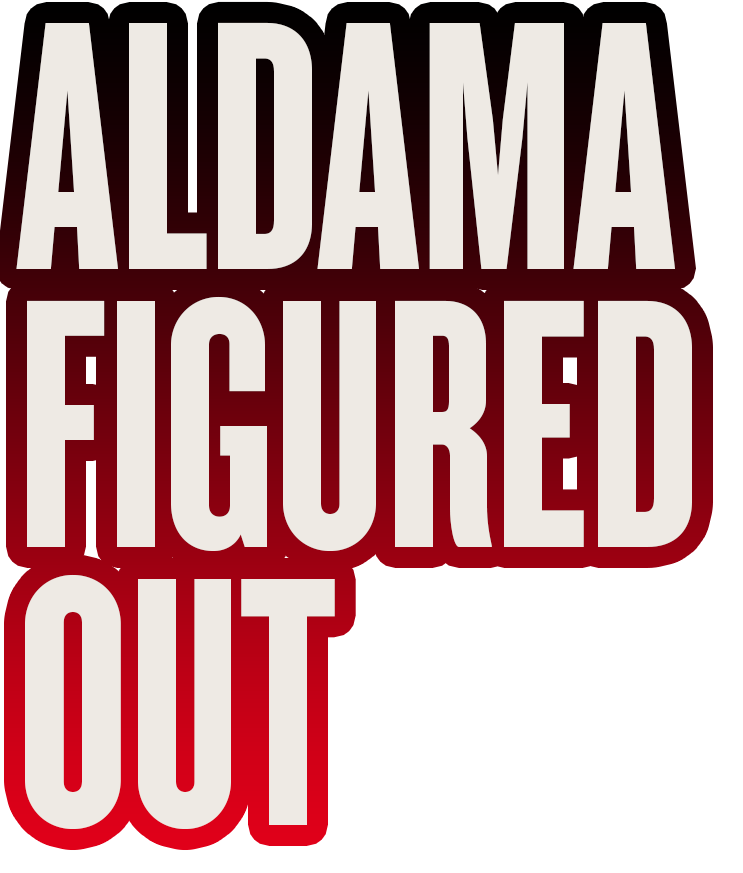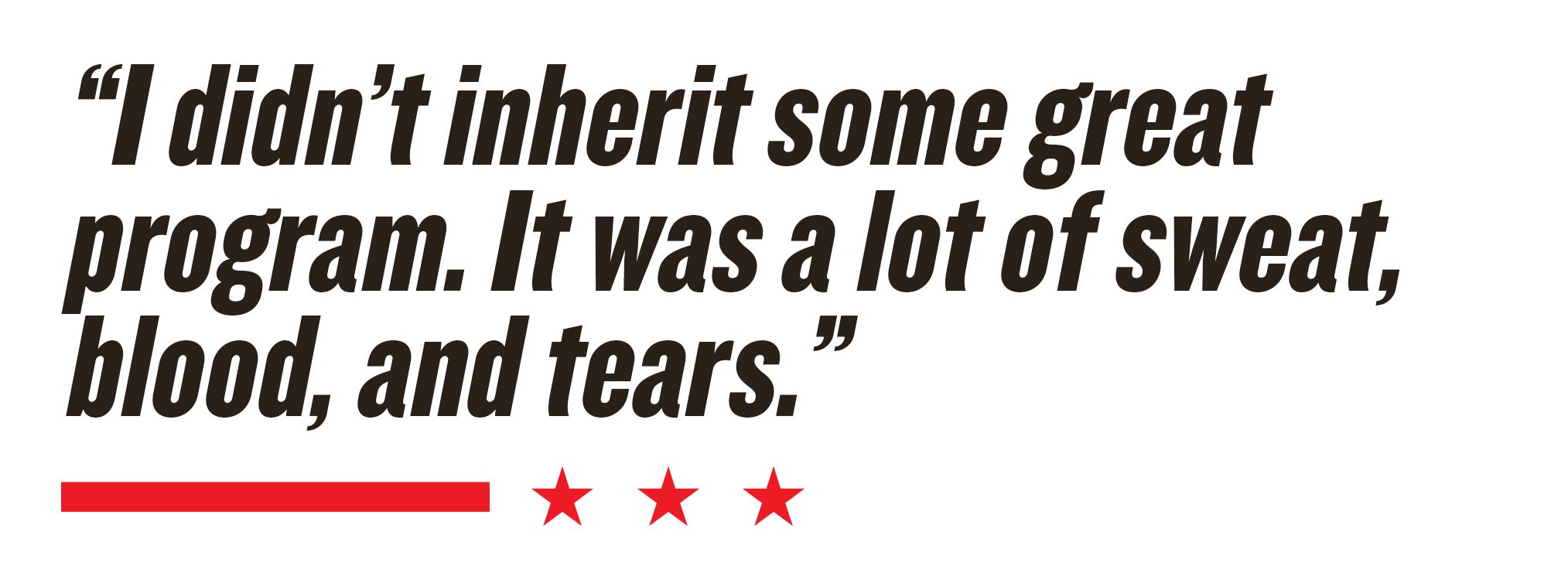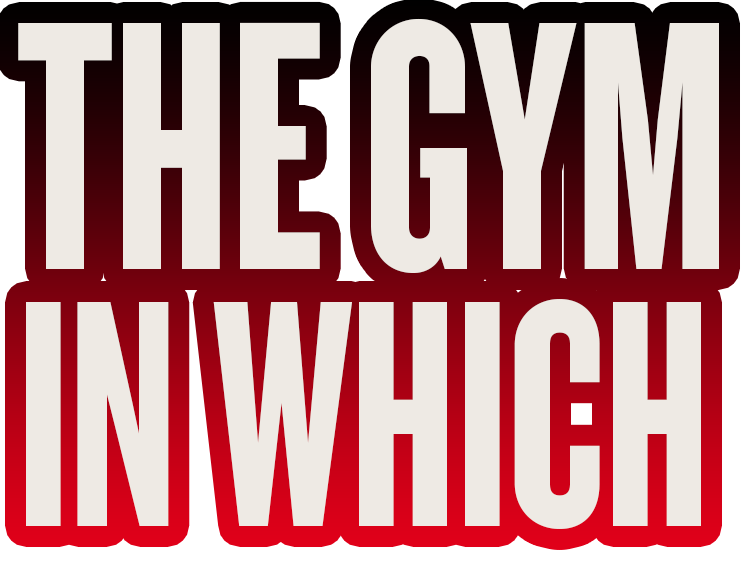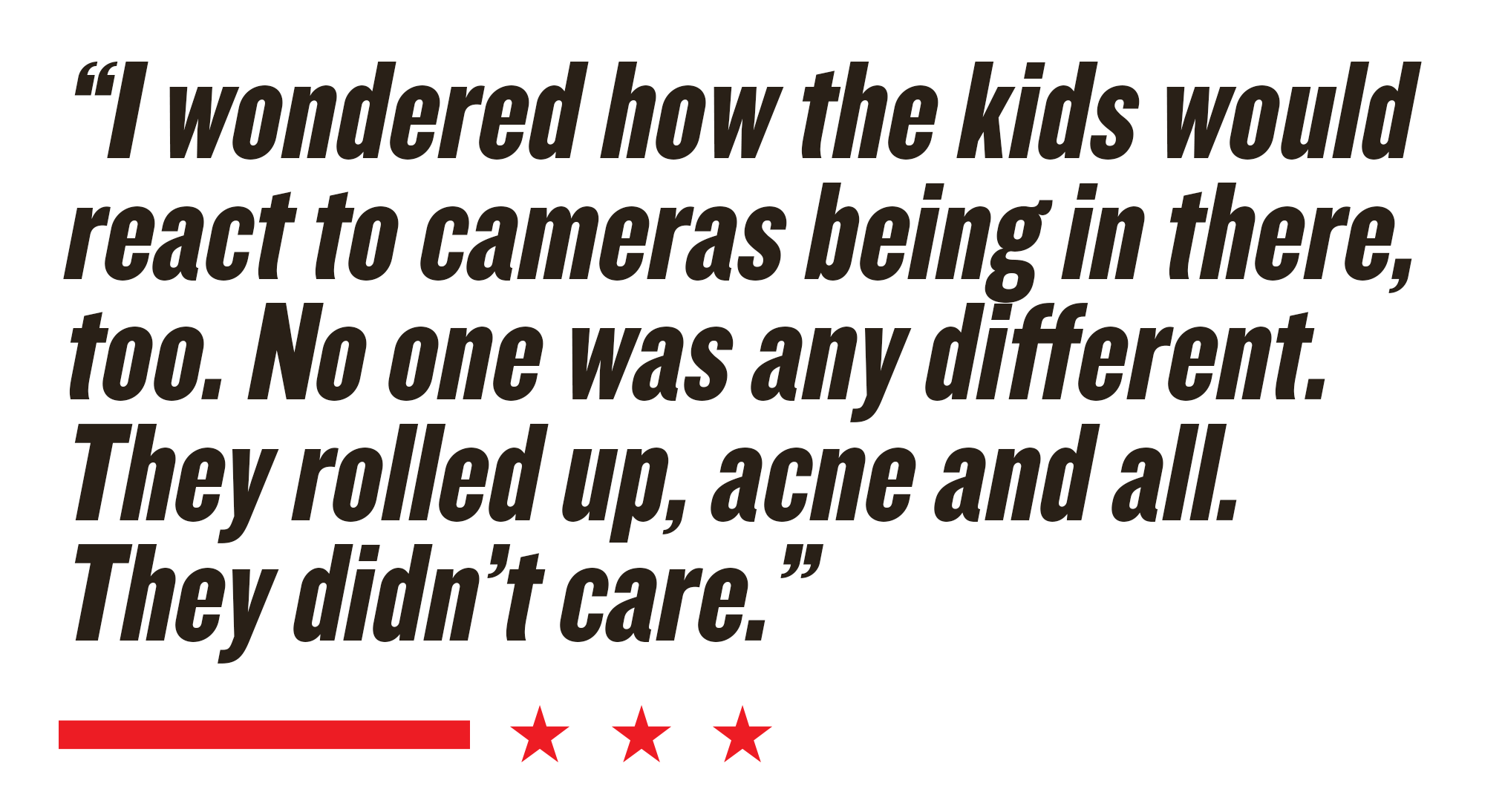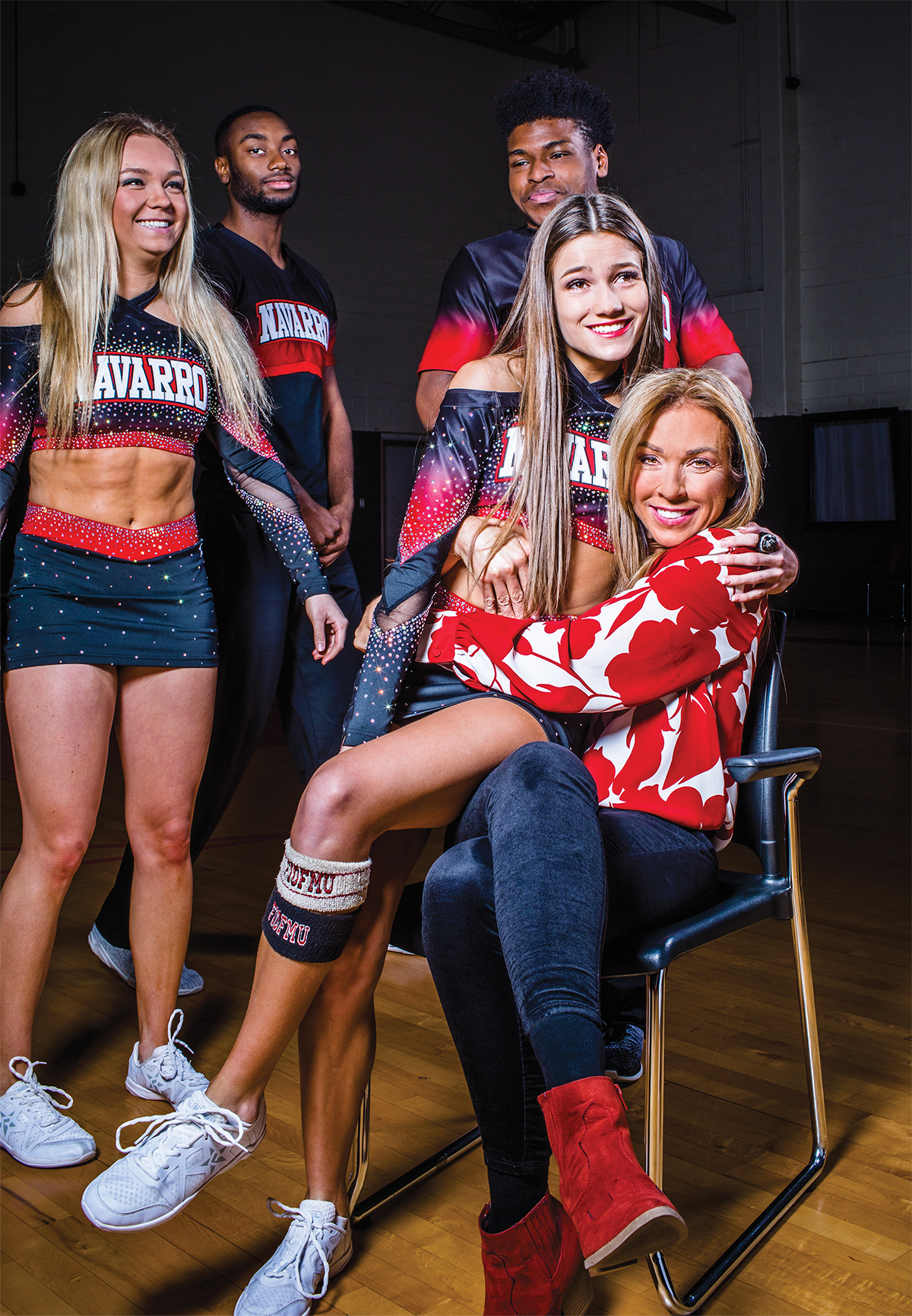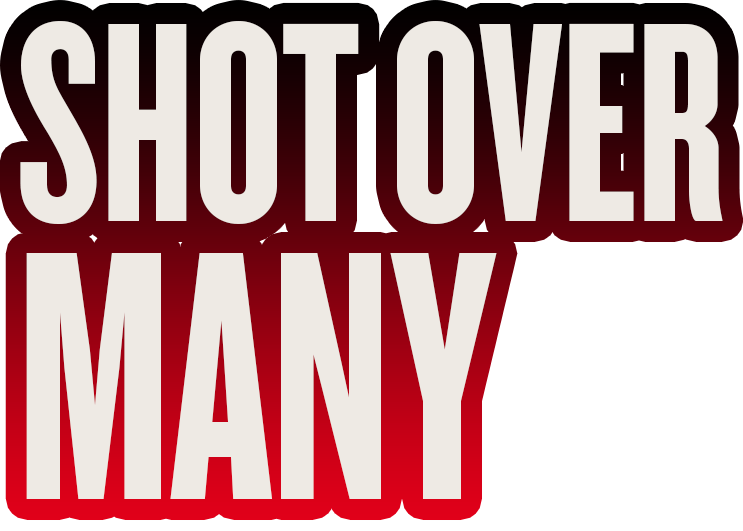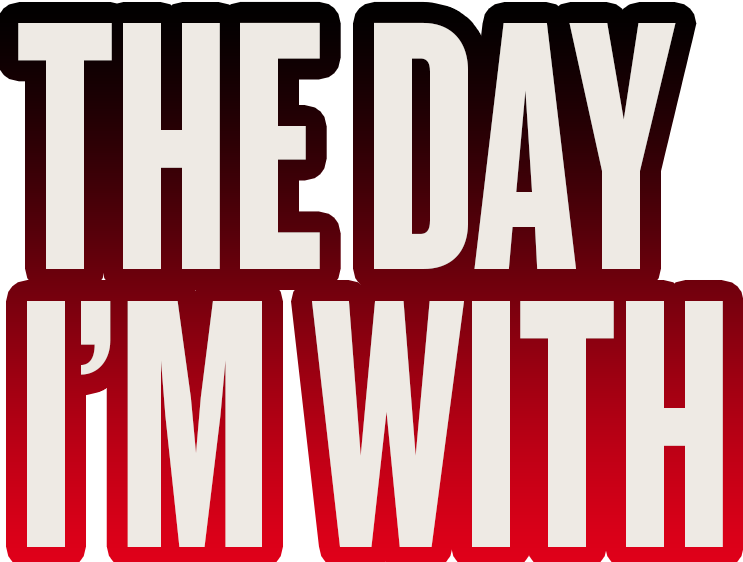Front row, Allie Ross, Head Coach Monica Aldama, Morgan Simianer; back row, TT Barker, Jerry Harris.
America has flipped for cheerleading coach Monica Aldama and her powerhouse team.
By Chris O’Connell
Photographs by Drew Anthony Smith
junior college in the world it would be a nondescript scene. It’s midmorning during the early spring semester, and a young woman in gray sweats and a baggy T-shirt, her blonde hair wet, stares at a bright phone screen as she sits cross-legged on the top floor of the school’s main gym.
But this is Corsicana, Texas, the only city in America with a junior college whose students have recently appeared on television shows with Oprah and Ellen, walked the red carpet at Hollywood events, and been personally spoofed in a skit on Saturday Night Live.
That student killing time before class isn’t just any student. She’s Lexi Brumback, one of the stars of Netflix’s recent smash hit Cheer, which followed the Navarro College cheer team through its 2019 season en route to winning the school’s 14th NCA Championship. She is famous now, and not just for her impressive tumbling, but for her heart-wrenching backstory and plucky spirit.
If you binge-watched Cheer when it was released in January, but failed to follow the various characters on their promotional tour or Instagram Live updates, you might be confused to see Brumback on the Navarro College campus. In the final episode, Brumback made clear that she was no longer on the team after finals in Daytona, Florida. But alas, she’s back, thanks to a second-chance given to her by Coach Monica Aldama, BBA ’93, Life Member.
When Aldama walks by, Brumback lights up. “Hi, Monica!” she says, her lips curling into an instant smile. In Brumback’s line of work, one of the main objectives is to appear cheerful even when she may not be. Aldama greets Brumback warmly.
But this is genuine, at least as far as I can tell. Brumback may be having another troubling social media interaction (like her Twitter kerfuffle during Cheer) or simply being a college student, inundated with tests and bills and a social life early in the morning. But when Aldama approaches, something in her changes.
Since Cheer aired, Aldama has been characterized in divisive terms. Actress Reese Witherspoon cried joyfully over the power of female leadership Aldama conveyed. The Atlantic called her leadership style as “take-no-prisoners” and the coach, in the middle of her 26th year at Navarro as, “an authority figure [her cheerleaders] dare not question.” Whatever you believe, Aldama is unflinching in her approach to coaching: that it’s more than teaching a team of cheerleaders how to build a pyramid or point their toes. It’s a family affair, and sometimes families fight.
“Some need the motherly touch. Some need discipline. They all need something different,” she says. “You figure it out, and you figure it out pretty quickly.”
how to win at Navarro College pretty quickly, too, winning her first NCA National Championship in her sixth season as head coach. But Aldama, a McCombs graduate, never saw cheerleading as a career.
Her family moved from Alabama to Corsicana when she was 6 years old, and she started in gymnastics shortly after. If she was born 25 years later, she might have gone straight to cheerleading.
“It was way different when I was young,” she says. “There weren’t opportunities like there are now. You have All-Star cheerleading and you can grow up from basically when you come out of the womb.”
Aldama cheered in junior high and high school, and just before graduation, she remembers hearing the words “All-Star,” indicating the first of a few big culture changes in the sport. Attending Tyler Junior College, she joined the cheerleading squad, but once she transferred to UT, she left it all behind.
“I loved it but I wasn’t planning on coaching,” Aldama says. Equipped with a finance degree, she dreamed of working on Wall Street. In the interim, she married her husband, Chris, and they moved to Dallas, where she took a job at a computer company. About a year in, the son of her cheerleading coach from Corsicana High called with an opportunity. He was the Navarro College assistant baseball coach, and noticed an opening for head coach of the cheerleading squad. Their lease in Las Colinas was coming to an end; Chris was already commuting to Waxahachie for work, about equidistant from Dallas or Corsicana; and, most importantly, she hated her job. She figured she’d apply and worry about everything else later. New York wasn’t going anywhere.
“I thought it was a stepping stone,” she says. “I’ll stay here for a little bit and decide what we want to do.” Her official hire date was in January 1995. She still hasn’t left.
For the first few years, Aldama lived in both the cheer and business worlds. She enrolled at UT Tyler in the MBA program and would work all day trying to build the then-lackluster cheerleading program, drive 80 miles to Tyler, take classes, drive back to Corsicana, get home around midnight, and do it all over again the next day. She was pregnant with her son Austin when she began and pregnant with her daughter Ally when she graduated.
And it’s not like she signed up for some turnkey coaching experience at Navarro. There were only 14 cheerleaders on the roster and the team had little-to-no name recognition in the sport when she arrived in December 1994, before her official start date. The team had no coach to bring them to nationals, then in Dallas, so she took them without really knowing any of the kids.
Instead of bailing and heading into business, though, she combined her two worlds. She created a business plan for the cheerleading team: Looking at the end goal and making a plan to get there, she says.
That end goal was having a fully functioning program where she could recruit the best talent in the world. To get there, she needed to win, and win soon. Winning, for this self-proclaimed “numbers person,” was as simple as figuring out the best way to score the most points in a way that other coaches were overlooking. In addition to poring over VHS tapes she ordered from previous competitions for style inspiration, she made a calculated move: she’d exploit the scoresheet.
Simply put, the scoresheet is the total possible points for different skills: building, tumbling, and overall performance. Aldama jumped on the opportunity to max out points in each category, rather than just try to put together the flashiest program.
“[Other coaches] had a mentality of, ‘We need to do the hardest thing we can here without looking at the big picture,’” she says. “I looked at it as, ‘We can get points in this category or this category or this category, and we are not going to focus on one thing, we are going to get the most points we can.’ That’s the education I got in business school.”
Recruiting back then was difficult without name recognition, so she’d drop in on the college’s weight room, she says, to “find some guys who looked like they were big enough to throw some girls around and try to teach them whatever I could.” And she didn’t exactly have the best top girls and tumblers to choose from, either.
“I didn’t inherit some great program,” she says. “It was a lot of blood, sweat, and tears.”
Every year, though, the team got closer to her goal, scoring more points, getting more name recognition at competition, and, in 1998 and 1999, coming in second place, the school’s highest-ever finishes. The following year, Navarro College won nationals, and Aldama’s squad never looked back. They have since won 13 more times—including five Grand National Championships, meaning scores higher than every other school, Division I universities included—and two in a row.
Along the way, Aldama gained a reputation for becoming the best coach in cheerleading, and the insular world of the sport noticed. It wasn’t until Cheer, though, that the rest of society took heed. Today, neophytes like me know what a basket looks like, how important mat talk is, and why they call Aldama “The Queen.”
Aldama’s team practices its record-shattering routines is not particularly pretty, even now. But access to it has changed significantly since Cheer.
Before Netflix descended on Corsicana, students and passersby could catch a glimpse of the best cheer program in the nation, if they knew to look in that very gym. (The show portrayed many locals as being rather oblivious to the paramount success of the squad.) Not anymore. Today, the windows of the practice gym are covered, either by red film or curtains. A local police officer is stationed by the door. There have been “several incidents,” I am told, without any specificity, but the implication is clear: these men and women are, in the age of social media, celebrities. But in the gym, during Daytona Season, they sure don’t act like they are enraptured by fame.
Attending Navarro Cheer practice—even just the warm up portion—is surreal in its normalcy if you’ve seen Cheer. Around 12:30 p.m., the Navarro College practice gym is empty, save for a few young women in sweats laying on benches and staring at their phones. As 1 p.m. approaches, a man with quads like oak stumps starts rolling out the mats. Then the familiar faces appear. Allie carries a white plastic laundry basket to the washers before helping tape up mats. Morgan, bubbly and free, smiles her way over to Allie, and the two stretch and goof around. Jerry and James wrestle playfully. Lexi, in UT sweats and a Naruto shirt, stares sullenly into the distance as a male cheerleader plays with her hair. I find myself looking around for Gabi Butler, who is back with the team but not around. It’s like an episode of the show is playing out in front of me.
I don’t know what I expected. Paparazzi? Oprah? Morgan getting dropped off in a Bentley? It’s almost like they are real college kids, just trying to get their associate degrees while three-peating in Daytona. And Aldama is just trying to keep winning, cameras or not. In fact, she initially didn’t understand why Netflix chose her.
“I told them,” she says. “I might yell every once in a while, but on a day-to-day basis that is not how I coach these kids. If that’s what you’re looking for, then this is not the team for you.” Netflix chose Navarro anyway, and it paid off.
Cheer succeeds because it’s a show about sports that’s not always about sports. Aldama decided early on that she couldn’t win at a junior college by being purely a cheerleading coach—she would need to be a life coach as well. The greatest sports stories have this emotional underbelly in common—Rocky did not win the 1976 Academy Award for Best Picture for its fight scenes.
“I didn’t know how it would go, but the girls rolled out of bed, their hair crazy, they didn’t put makeup on, they didn’t become anyone different than who they already were,” Aldama says. “Which I think was so awesome and one of the reasons the show is so popular—everyone was so raw and authentic.”
Aldama attributes the success of Cheer to the verisimilitude of the cheerleading lifestyle, rather than some sort of fantasy about what the outsiders could have projected upon it.
“I wondered how the kids would react to cameras being in there, too,” she says. “No one was any different. They rolled up, acne and all. They didn’t care.”
From my short time in Corsicana, it appears that what you see on Netflix is what you get, for the most part. Aldama is who she appears to be—tough but fair, the motherly figure you strain to not disappoint.
Case in point: the day of her photoshoot for this magazine. Aldama clearly relishes her time at UT, specifically the foundational knowledge she acquired at McCombs. So when one of the main stars of the show, Jerry Harris, is sleeping in that morning, his teammates, all primped and primed for the bright lights, take him to task, not unlike how the team holds each other accountable during a stunt. They FaceTime him, and a groggy Harris answers.
“Get over here!” they insist. “And put the black uniform on.”
A star college athlete has a decision to make here. Does Harris need to roll out of bed and be in a few shots with his coach? After Aldama, he’s arguably the most famous member of the team, with one million Instagram followers and a recent stint interviewing celebrities on the red carpet during the Academy Awards. But that’s not how all this works at Navarro College.
Within minutes, he’s there, the black uniform on his newly slender body and that million-dollar smile plastered on his face. Aldama ribs him in a firm but gentle way: You messed up, I see you, her face says. That’s Aldama the counselor: Harris can’t expect to oversleep important moments in his life, especially now.
Clockwise from left, Kassidy Warnol, James Thomas, Jerry Harris, Morgan Simianer, Monica Aldama.
When Aldama sits for her portrait, Morgan Simianer hops into her lap, and her coach gives her a squeeze. Abandoned by her parents, Simianer was raised by her grandparents, and Cheer portrays the initially raw talent as searching for maternal love. That’s Aldama the surrogate mother.
But both moments are strands of Aldama the coach. That Harris’ teammates held him accountable is a product of Aldama’s coaching philosophy. On the show, if someone drops a flyer, everyone does pushups. If someone misses class, everyone runs.
“It seems to work so well because they realize if they mess up, other people are going to be hurt in some way from that,” she says. “Show up if you have a job. Let’s all do our job and hold each other accountable to that level of excellence.” The shot is objectively less compelling without Harris in it, and the team knows it.
That Morgan felt comfortable enough to jump into Aldama’s lap—and that Aldama didn’t flinch—is another strand. She is fluid in her methodology, and is adept at signaling which team members need what from her.
“Some people want to be yelled at, they want you to get in their face because it will motivate them. Other people will melt down and you will never get another thing out of them,” Aldama says. “You have to know, what does this person need? A gentle confidence booster? For me to be harder on them? You learn from their personalities what they need.”
Andy Cosferent, Aldama’s right-hand man at Navarro, figured out pretty quickly that he needed to be in Corsicana.
In 2012, the Montreal native visited schools in the United States because he wanted an education here, and, importantly, competitive cheerleading (especially back then) wasn’t nearly as big as it is in the U.S. He says he came to Navarro College one weekend, and “completely fell in love.” He cheered for Aldama through Daytona in 2015.
Even though Navarro College Cheer didn’t have an official assistant coach position until the Cheer season, Cosferent volunteered, driving down from Dallas whenever Aldama needed him. He says they are extremely close. Even though she is his boss, he can turn to her with a personal issue, and, even though he isn’t an 18-year-old “lost soul” like some of her kids, she will still give him the love he needs.
“If I have something where I need advice,” Cosferent says, “she’s one of my top people.”
Cosferent says Aldama has helped the team members who appeared on Cheer deal with their newfound fame. As a result, Cosferent has helped shoulder Aldama’s burden. He says she might be doing interviews for six straight hours before practice, and because he can step in wherever she needs him, there is more trust between them than ever.
“This program means the world to me,” he says, “and so does Monica.”
weeks and distilled into six hours, there’s a lot Cheer can’t show. The Daytona section, especially, omitted a piece of the storyline, no doubt in part to the fact that Varsity Spirit, the company that operates the NCA, barred Netflix from filming at the competition.
Thus, most of the shots from finals are from the point-of-view of the audience, as the footage is crowdsourced from them. Aldama says the bandshell in Daytona is so special because it is overflowing with people, and the cheerleaders get an adrenaline boost from the energy in the crowd. During the first portion of their routine, before Austin Bayles injured his ankle, that was true. But Aldama says Cheer didn’t show what happened after they returned from their 20-minute injury timeout.
“Everyone left to go to lunch,” she says. “When we came back out, I walked around the corner and gasped … there was nobody out there, hardly.”
She saw Chris, her son Austin, the president of the college, and their athletics director, and not many more people. She sent a panic-text to her alumni group chat pleading with everyone in Daytona to get to the bandshell immediately. Her Navarro crew pushed to the front, but the team had to perform its national championship-winning routine from the moment of the injury to a mostly empty crowd.
“I was terrified that there was no one there,” Aldama says. “Somehow we made it through.” The team won, and around midnight, Aldama found herself in the hotel lobby enforcing the team’s curfew. Right around the stroke of midnight her phone started buzzing uncontrollably. “Is everything OK?” and “What’s going on?!” and “What happened?” flooded her message inbox. There is notoriously lousy cell phone service in Daytona during nationals, and it seems her message had just gone through.
Aldama also takes exception to the notion that she is brazen about the safety of her team members. Notably, a male cheerleader named TT Barker practiced through a hurt back, Simianer quietly visited an ER between practices, and, dramatically, Mackenzie Sherburn, or, “Sherbs” as she’s known, dislocated her elbow after failing to be caught during pyramid practice.
“Most everything has been very positive, but a little bit of the negative was how dangerous it was, and it is dangerous,” Aldama says. “They pretty much showed every time we fell and not the 1,000 times we got it right.”
Aldama says that she got “dinged” for her handling of Barker’s injury, but that he was allowed to practice even though it would hurt, and that he didn’t practice fully anyway. She insists that Morgan’s ribs were fine. And, of the fall that kept Sherbs off the mat in Daytona and caused a mass of think pieces about how unsafe cheerleading has become in the arms race that is winning nationals, she has a lot to say.
“Since you didn’t get to see the safety progressions we took, the pyramid for example, people thought we were throwing people around without any care for their health, which was not the case at all,” she says. The fall Sherbs took on Cheer was especially brutal because it looked like no one was even in the vicinity to catch her. It was part of a switch-out in the routine, and the male cheerleaders meant to be there hadn’t finished their progression to be there yet. Aldama immediately abandoned the switch-out.
“When Sherbs got hurt we changed it so it was way safer,” she says, “so it would never happen again. We are much safer than it probably looked on the show.”
Navarro College Cheer, they agree to perform a pyramid, part of their new routine for Daytona, which is just over a month away. It appears that I’m one of the only outsiders who will ever see it. On March 15, Varsity Spirit announced the cancelation of the NCA Cheer & Dance Competition due to the worldwide COVID-19 pandemic. It’s the first time in 40 years the event will not be held.
Cheer star La’Darius Marshall posted a video of himself during a gameday cheer routine, lamenting the cancelation, but more so professing his love for the team. Aldama commented, “My heart is breaking!!!! I love you forever!!!!” with a trio of red heart emojis, to which Marshall responded, “FOREVER, I will never thank a woman as much as I could thank you for helping me grow into the man I am today. You’re the best Coach/Mom I could have ever asked for.”
There is no doubt that Daytona was off the table once the NBA went on hiatus and the NCAA Tournament was canceled, and with good reason. The most important thing is for everyone to stay safe and prevent the spread of the virus. For most of the team though, this is it for them at Navarro. This might be the end of their cheerleading careers. In fact, Marshall confirmed that cheerleading was behind him in an April 1 profile in New York Magazine’s The Cut.
Before COVID-19 altered the course of life as we know it, I asked Aldama what it would take for her to walk away from Navarro. For someone as competitive as she is, it would seem no situation is right for her swan song. Coming off a loss, she’ll want to avenge it; on the heels of a win, she will want to make sure she isn’t leaving anything on the table. It’s the Tom Brady paradox.
“It’s unfinished business, as of now,” she says. “I’m not closed off to opportunities outside the cheer world.” Aldama says that she is young enough to retire from coaching and start a new career in business.
But she also has no desire to coach anywhere else, nor does she want to leave Corsicana right now.
It would appear that Kentucky or Texas Tech or one of the other major-college cheerleading powerhouses would come knocking, though, right? Aldama says that the lateral moves from junior college to Division I are not the same as they are for football or basketball coaches. Once, a D1 school asked through in intermediary if she'd be interested in making a move. She didn’t even entertain the idea. The money isn’t there, and besides, many schools don’t do both gameday and competitive cheerleading. And now, with Cheer and Oprah and Ellen and everything else, she has more name recognition than any cheerleading coach in the country. She could write her own ticket anywhere. Perhaps the worldwide outbreak will change things, but in her office this February, in a seemingly different world, she was firm in where she wanted to be.
“This is my baby,” Aldama says. “I built it. This is where my heart is.”
Stories like these are supported by membership in the Texas Exes.
Join today to receive the bimonthly Alcalde magazine, and help keep alumni connected to UT.
